|
Top of
Page |
|
|
| |
|
|
.22 Hornet Contender 14" |
.222 Rem. Encore |
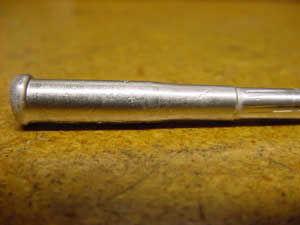 |
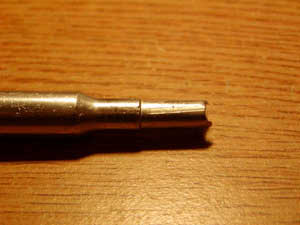 |
| |
|
.30/30 factory chamber with a proper, true throat
(30/30
factory Super 16 barrel) |
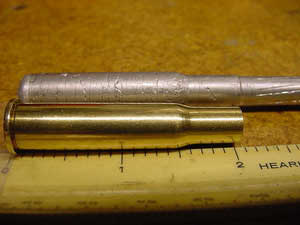 |
This is what a throat should look like, and if it is aligned with the bore
gives the best probability of good accuracy.
Over the years TC factory .30/30 chambers have been cut
in a number of configurations, some excellent like this one, while some
vintages had NO throat at all.
Note that in front of the chamber neck the rifling are
cut away for a significant
distance giving a steel cylinder to positively align and
support the shank of the bullet as it enters into the rifling. |
| |
|
.30/30 factory chamber
with NO throat! |
|
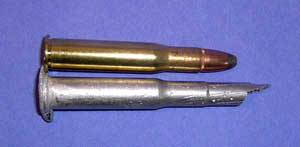
|
|
.30/30 Remington factory ammo and chamber cast of a recent vintage TC
factory S-14 barrel. |
|
Older vintages of
factory .30/30 chambers like the one above had a true throat in them, but
since the early 90's, TC has gone to a chamber that has NO throat in it.
You can see the chamber neck is about .050" longer than the case of this
Remington factory round, then there is about another .050" taken up by a
an abrupt cone that runs right to the ends of the rifling. There is NO
further leade on the ends of the rifling.
About .050" in front of the cannelure on the bullet you
can see where its .308" diameter shank ends, and it is at this point
approximately that the bullet hits the abrupt ends of the rifling. There
is nothing to align the shank of the bullet with the bore except for the
case neck.
Controlled tests have shown dramatically that this type
of chamber normally produces, in the words of the one doing the test,
"dismal accuracy" with groups averaging from 2" to 4."
This factory round in this particular barrel, by the
way, fell .005" BELOW the end of the barrel. The barrel-to-frame gap
reported by the owner was .004." .005" plus .004" gives a total headspace
of .009," .003" over maximum.
.30/30 can be very, very
accurate, but not when the accuracy potential is seriously
undermined by this no-throat chamber design. Choosing such a design
is a waste of your money and an insult to the American gun making
trade in my studied opinion.
Mike Bellm.
|
|
|
Top Of Page |
|
.357 Magnum Contender
12" |
Same barrel as at left re-chambered to .357 Max. with a true throat
at the case mouth. |
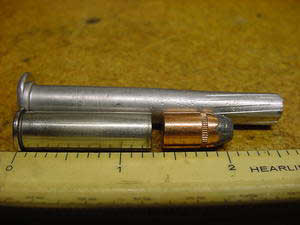 |
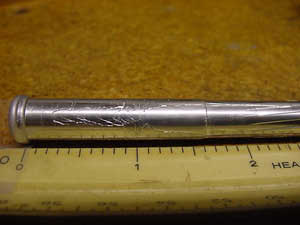 |
|
Note how far a
bullet is out of the case before it even touches the rifling and
that there is NO cylindrical section to guide and support the shank
of the bullet as it is engraved by the rifling. The rear of the
forcing cone is the same diameter as the chamber neck and tapers
down to bore size, the distance across the tops of the rifling, over
a total distance of about .4" |
|
|
Note where the
chamber neck ends at the case mouth compared to the above cast where
there is no visible break.
There is some of the original cone remaining, but there is a
distinct step down at the case mouth. Forward of where the original
cone ended, a throat is extended forward .2" |
|
|
|
|
.357 Mag. older 10 inch
barrel |
.44 Mag. factory chamber |
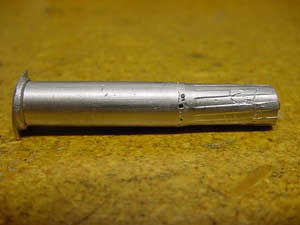 |
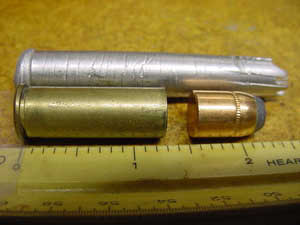 |
|
Short conical throat
for less bullet jump, but no real support of the shank of the bullet |
|
|
Mid 90's vintage,
14" Contender. Bullet is positioned where it would first contact the
rifling. Note the distance from the case neck to the base of the bullet |
|
|
|
|
.45 Win. Mag. 14" barrel |
.45/70 Encore Katahdin |
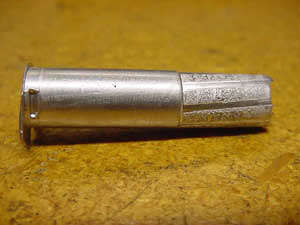 |
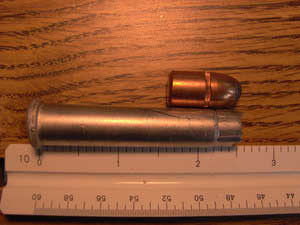 |
|
Note: NO throat
whatsoever |
.45/70 factory chamber, no throat |
|
Top Of Page |
The
factory chamber has no throat, only an approx. 45 degree chamfer at the
end of the chamber. The rifling go all the way back almost to the mouth of
the case making it necessary to seat bullets extremely deep in the case.
Factory ammo has bullets seated deeply enough to work with the TC factory
chamber, but as noted here, component bullets such as this have to be
seated below the cannelure. The point forward of the cannelure on this 350
gr. Hornady bullet where the full .458" diameter shank ends is lined up
with the ends of the rifling. Note how deeply this bullet must be seated
into the case neck and that there is no cylindrical throat section to
support the shank of the bullet as it is engraved by the rifling. |
|
|
.45/70 rethroated |
.45/70 throat comparison |
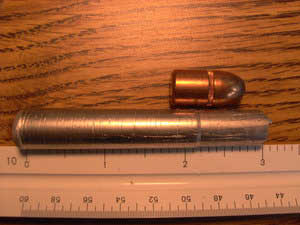 |
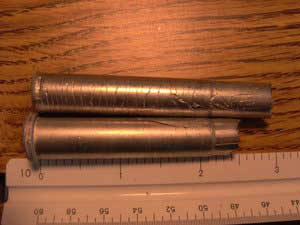 |
|
.45/70 re-throated with throat cut in .300" long. |
|
Here are the
two casts of the same chamber side by
side.
Bottom, factory chamber. Top, same chamber with throat extended .3" |
|
| |
Same 350 gr. Hornady bullet is positioned where
it would contact the rifling. Note there is an ample amount of
bullet shank that would still be in the case where there is a
significantly long cylindrical section at just under .459" diameter
to guide and support the shank of the bullet as the rifling engrave
the bullet.
A longer 405 gr. bullet would have more shank in the
case, a 300 gr. slightly less while both can still be seated to the
rifling.
The length of throat cut can be tailored toward lighter
or heavier bullets or even for specific bullets seated to a specific depth
based on dummy rounds the customer supplies.
In the photo above, for example, one could hold the
throat length back about .050" and be closer to optimum with 300 gr.
bullets, or the throat can be cut longer for 400 to 500 gr. or heavier
bullets.
In the Encore, if desired, one can come pretty close to
.458 Win. Mag. performance with 500 gr. bullets by seating the bullets out
into a substantially longer throat, thus creating the necessary powder
capacity. The action itself will handle .458 Win. Mag equivalent loads,
however, the thinner .45/70 brass may not last as long as the heavier .458
Win. Mag. brass.
Unlike a bolt action .458 Win. Mag., rounds are not
subjected to battering in a magazine box under recoil. Thus bullet neck
tension is not an issue, and less bullet shank in the case is not a
problem. Speaking of .458 Win. Mag., of course the .45/70 barrels can be
re-chambered to .458 Win. Mag. also. Either way, your Encore can be
properly outfitted and ready when dinosaurs raid your pea patch. |
|
|
|
|
Top Of Page |
|
|
|
Here are two
casts of the same chamber side by side. |
|
|
.300 Whisper with
misaligned throat, TC custom shop |
Rotated approx. 180
degrees |
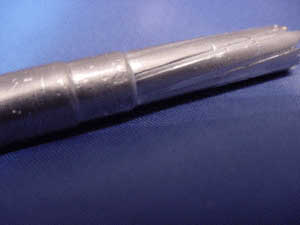 |
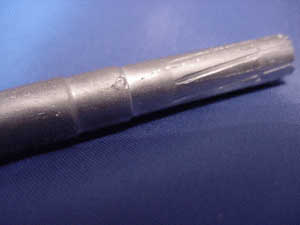 |
|
.300 Whisper TC custom shop, offset/misaligned throat. |
|
|
.300 Whisper TC custom shop, view from opposite side of casting. |
|
|
Note that due
to the small capacity of the parent .221 Fireball case, bullets for
.300 Whisper are normally seated out of the case neck some distance.
As you can see here, the rifling extend all the way back to the end
of the chamber neck. |
|
|
Here you can
see the rifling are cut away, as they SHOULD be normally, so the
bullet can extend up into the bore outside of the case neck.
|
|
| |
However, since the rifling go all the way to the
neck on one side and are cut away on the opposite side, this forces
the bullet out of alignment with the bore. It is simply stated,
pointed in a different direction!
Also, observing the shrinkage and growth factors
of Cerrosafe casting alloy, preliminary measurements indicate the
diameter of this throat to be about .311," .003" larger than bullet
size, when ideally the difference between throat diameter and bullet
size should be about 1/10th of that, .0003" for better support and
guidance of the shank of the bullet as it enters into the rifling.
With this degree of "slop" around the bullet shank
and the gross misalignment of the throat with the bore, how can one
expect such a barrel to be accurate, in spite of the premium price
paid for this stainless steel "custom shop" barrel?
The only hope
for such a barrel is to cut a longer chamber into this barrel, one
that will cut out all of what the factory cut; i.e., the neck of the
new chamber must extend forward of where the rifling start as
indicated by this casting.
A new throat is then cut in the bore ahead of the
new neck. Steps must be taken to insure that the new throat is cut
centered with the bore, which is what I do routinely.
|
|
|
|
|
|
.454 Casull
Factory Throat. |
|
|
.454 Casull
Factory Throat |
|
|
Small wonder accuracy is mediocre with
this round. |
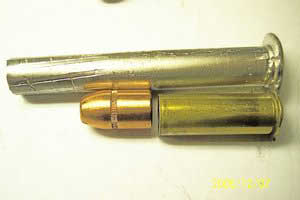 |
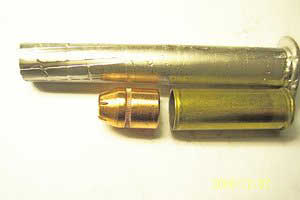 |
|
Pic #1, 300 gr. bullet. Note that even a 300 gr. bullet is
completely out of the case neck before contacting the end of the
cone/start of the rifling. The bullet measures .451" while the area
in the barrel at the base of the bullet is about .480" and gives NO
alignment of the base of the bullet with the bore. |
|
|
Pic #2, 250 gr. bullet even further from the case neck. |
|
|
|
"Ray" made this
contribution to the library showing the existing factory throat and steps
he took to compensate for the poor SAAMI chamber design for this round.
Mike, Here are some pics for your throat library. #1 is a 300 gr. hp, #2
is a 250 gr. hp, #3 is my fix. I started with 400 gr. 45-70 .458" sized to
.452" seated one to second groove group got better seated second in first
groove better yet went a 450 gr. lead .458" sized to .452" set on rifling
1.5" group at 50 yards. Originally it was 3.5 "thought you might like to
hear about this. Ray |
|
|
|
Compensating for the
overly long, cone shaped throat above... |
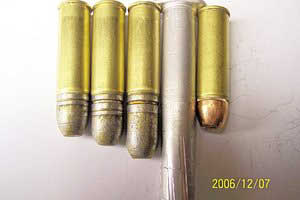 |
|
Note that in each
instance there is still no guidance or support of the base of the bullet
sitting in an overly large diameter area. |
| |
|
On the other hand, if the .454 Casull or any other round
is given a true, cylindrical throat that supports the shank of the bullet,
superior accuracy results. As it is, the SAAMI designs "the industry" is
strapped with is costing you money and not giving you the accuracy you
expect... and deserve. |
|
|
|
Top Of Page |
Return To Bellm Article
Index |
Return To LASC
Front Page |
|
This article reprinted
with permission of Mike Bellm and
Bellmtcs.com |
|
| |
|
Warning: All technical
data mentioned, especially handloading, gunsmithing and bullet casting,
reflect the limited experience of individuals using specific
tools, products, equipment and components under specific
conditions and circumstances not necessarily reported in the
article or on this web site and over which The Los Angeles Silhouette Club (LASC), this web site or the author has no control. The above
has no control over the condition of your firearms or your
methods, components, tools, techniques or circumstances and
disclaims all and any responsibility for any person using any
data mentioned. Always consult recognized reloading manuals. |
| |
|
|
|















